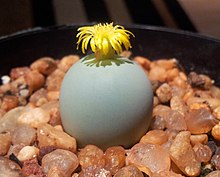
Lithops is a genus of succulent plants in the ice plant family, Aizoaceae. Members of the genus are native to southern Africa. The name is derived from the Ancient Greek words λίθος 'stone' and ὄψ 'face', referring to the stone-like appearance of the plants. They avoid being eaten by blending in with surrounding rocks and are often known as pebble plants or living stones. Lithops is both the genus name and the common name. The formation of the name from the Ancient Greek -ops means that even a single plant is called a Lithops.

Sempervivum arachnoideum, the cobweb house-leek, is a species of flowering plant in the family Crassulaceae, native to European mountains, in the Alps, Apennines and Carpathians. Growing to 8 cm (3 in) tall by 30 cm (12 in) wide, it is a rosette-forming succulent perennial, valued in cultivation for its ability to colonise hot, dry areas via offsets.

Conophytum is a genus of South African and Namibian succulent plants that belong to the family Aizoaceae. The name is derived from the Latin conus (cone) and Greek phytum (plant). The plants are also known as knopies, waterblasies, sphaeroids, conos, cone plants, dumplings, or button plants.

Crassula tetragona is a succulent plant native to Southern Africa. It is widely distributed from the Orange River boundary of Namaqualand to beyond the Kei River in the Eastern Cape. "Tetragona" comes from the phyllotaxy of the leaves. It is popularly named the "miniature pine tree" among ornamental plant enthusiasts, for its popular use as a "pine tree" in Bonsai.

Argyroderma is a genus consisting of over 50 species of succulents in the iceplant family from South Africa.
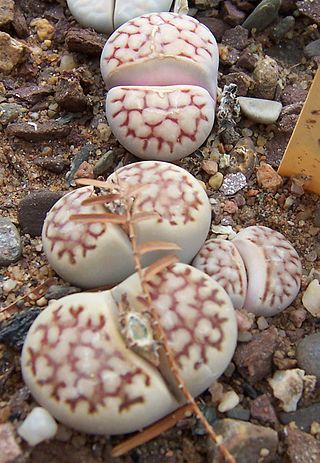
Lithops karasmontana, is a species of flowering plant in the ice plant family Aizoaceae, native to Namibia and South Africa.
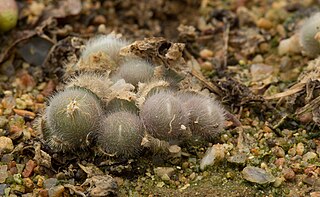
Conophytum stephanii is a small South African species of Conophytum succulents named after German plant collector Paul Stephan, who tended the succulent collection at the Hamburg Botanic Garden in Hamburg, Germany. The plant was first described by Dr. Schwantes in 1929 and published in "Die Gartenwelt" 33:25.
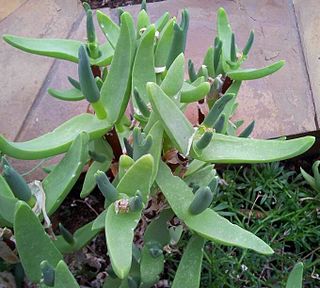
Mitrophyllum is a genus of succulent plants of the family Aizoaceae, indigenous to the arid region around the Richtersveld, on the border of South Africa and Namibia.

Conophytum burgeri is a small, endangered, South African species of succulent plant, of the genus Conophytum.

Conophytum breve is a small South African species of succulent plant of the genus Conophytum.

Conophytum flavum, the yellow cone plant, is a small South African species of succulent flowering plant of the family Aizoaceae.

Conophytum ficiforme is a small South African species of succulent plant of the genus Conophytum.

Conophytum truncatum is a small South African species of succulent plant of the genus Conophytum.

Conophytum piluliforme is a small South African species of succulent plant of the genus Conophytum.
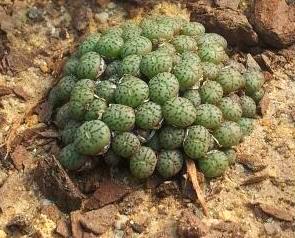
Conophytum minimum is a small South African species of succulent plant of the genus Conophytum.
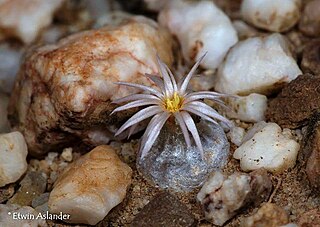
Conophytum hammeri is a small, endangered, South African species of succulent plant, of the genus Conophytum.

Crassula pellucida is a creeping, succulent ground-cover, or low-growing, spreading succulent shrub, indigenous to South Africa.

Conophytum obcordellum is a species of flowering plant in the family Aizoaceae, native to the Western Cape of South Africa. It is a small clump-forming succulent, growing to 10 cm tall and 1m broad, forming glossy grey pebble-shaped growths, heavily marked with dots and lines. Daisy-like, silky white or pink night-scented flowers are borne on mature plants in spring.

Babiana sambucina is a species of geophyte of 8–30 cm (3.1–11.8 in) high that is assigned to the family Iridaceae. It has dense spikes of blue to violet-coloured, often fragrant flowers. There are two subspecies, B. sambucina subsp. longibracteata is restricted to a small area in the Northern Cape, B. sambucina subsp. sambucina grows in the Western Cape and Eastern Cape provinces of South Africa. Flowers are present in August and September.
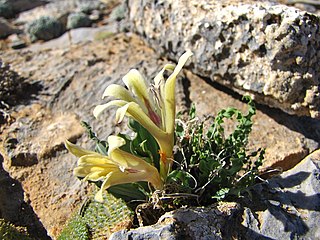
Babiana cinnamomea is a perennial plant of about 4–6 cm (1.6–2.4 in) high that annually forms leaves and flowers from an underground corm that is assigned to the iris family. It has inconspicuous pale greenish yellow flowers and broad, hairless, pleated leaves with undulating margins. Flowers may be found in May and June. It occurs in the very north of the Western Cape province of South Africa.
